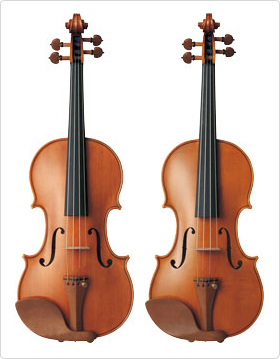The origins of the Violin
The modern violin
Now everyone can easily experience these famous instruments
The Cremona violins are vastly superior in quality, but these famous instruments are extremely expensive, and so very few people can actually play one. However, through advances in technology, we can easily obtain instruments that are very similar to these famous instruments.
Yamaha used the latest technology to perform a painstaking analysis of the violins of Antonio Stradivari and Guarneri del Gesu, and using this data, they have combined technology that reproduces the hand-finished results of the past with an artisans skill to produce high quality, reasonably priced violins. These are the Artida models S and G.
The S model has rigid shoulders, and the f-holes run just about parallel with the line of the body, while the G model has sloping shoulders, and the f-holes are more slanted. Each has its own characteristic tone.

Artida S (left) and G (right)
Bows in the age of environmental awareness
The preferred material for the stick of the violin bow has been pernambuco wood, which only grows in the Amazon delta region in South America. Originally, it was exported to Germany for use in creating dyes, but because of its unusual hardness, it began to be used to make bows. However, in recent years, this natural resource has began to become depleted. Tree farms were also created, but it takes 30 years for this tree to attain full growth.
The carbon bow shown in the figure below uses carbon instead of wood. Developed to protect the global environment while ensuring that the seeds of music continue to germinate, carbon bows have has good gripping characteristics and are long lasting.

Carbon bow
Musical Instrument Guide : Violin Contents
Origins
Structure
How to Play
How the Instrument is Made
Choosing an Instrument
Care and Maintenance
Trivia
- The f-hole used to be a C-hole or S-hole
- Why the f-hole?
- Violinists must bow to the horse
- Steel strings or gut strings? That is the question
- Is the chinrest the unsung hero of the violin?
- Most violin varnishes are also medicines
- Violin masterpieces: Solos I
- Violin masterpieces: Solos II
- Violin masterpieces: Solos III
- Violin masterpieces: Concertos I
- Violin masterpieces: Concertos II
- Viola masterpieces: Chamber music
- Viola masterpieces: Concertos
- Cello masterpieces: Concertos I
- Cello masterpieces: Concertos II
- Cello masterpieces: Solos
- Contrabass masterpieces: Concertos
- Contrabass masterpieces: Chamber music
- Orchestral masterpieces featuring the contrabass
- What do you call the part on the bow that you hold?
